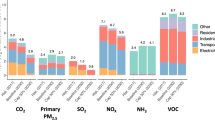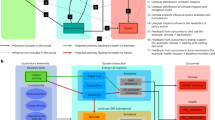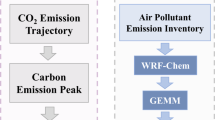Abstract
Because human activities emit greenhouse gases (GHGs) and conventional air pollutants from common sources, policy designed to reduce GHGs can have co-benefits for air quality that may offset some or all of the near-term costs of GHG mitigation. We present a systems approach to quantify air quality co-benefits of US policies to reduce GHG (carbon) emissions. We assess health-related benefits from reduced ozone and particulate matter (PM2.5) by linking three advanced models, representing the full pathway from policy to pollutant damages. We also examine the sensitivity of co-benefits to key policy-relevant sources of uncertainty and variability. We find that monetized human health benefits associated with air quality improvements can offset 26–1,050% of the cost of US carbon policies. More flexible policies that minimize costs, such as cap-and-trade standards, have larger net co-benefits than policies that target specific sectors (electricity and transportation). Although air quality co-benefits can be comparable to policy costs for present-day air quality and near-term US carbon policies, potential co-benefits rapidly diminish as carbon policies become more stringent.
This is a preview of subscription content, access via your institution
Access options
Subscribe to this journal
Receive 12 print issues and online access
$209.00 per year
only $17.42 per issue
Buy this article
- Purchase on Springer Link
- Instant access to full article PDF
Prices may be subject to local taxes which are calculated during checkout



Similar content being viewed by others
References
Bell, M. L., Dominici, F. & Samet, J. M. A meta-analysis of time-series studies of ozone and mortality with comparison to the national morbidity, mortality, and air pollution study. Epidemiology 16, 436–445 (2005).
Pope, C. A., Ezzati, M. & Dockery, D. W. Fine-particulate air pollution and life expectancy in the United States. N. Engl. J. Med. 360, 376–386 (2009).
US EPA Area Designations for 2008 Ground-Level Ozone Standards (Office of Air and Radiation, 2012); www.epa.gov/airquality/ozonepollution/designations/2008standards/index.htm
US EPA Fine Particle (PM 2.5 ) Designations (Office of Air and Radiation, 2012). www.epa.gov/pmdesignations/
IPCC, Climate Change 2007: The Physical Science Basis (eds Solomon, S. et al.) (Cambridge Univ. Press, 2007).
IPCC, Climate Change 2013: The Physical Science Basis (eds Stocker, T. F. et al.) (Cambridge Univ. Press, 2013).
Nemet, G. F., Holloway, T. & Meier, P. Implications of incorporating air-quality co-benefits into climate change policymaking. Environ. Res. Lett. 5, 014007 (2010).
Interagency Working Group on Social Cost of Carbon (IWGSCC), Technical Update of the Social Cost of Carbon for Regulatory Impact Analysis Under Executive Order No. 12866 (United States Government, 2013); www.whitehouse.gov/sites/default/files/omb/assets/inforeg/technical-update-social-cost-of-carbon-for-regulator-impact-analysis.pdf
Greenstone, M., Kopits, E. & Wolverton, A. Developing a social cost of carbon for US regulatory analysis: A methodology and interpretation. Rev. Environ. Econ. Policy 7, 23–46 (2013).
Griffiths, C. et al. in Fiscal Policy to Mitigate Climate Change: A Guide for Policymakers (EPub) (ed Ruud de Mooij, I. et al.) Ch. 4 (International Monetary Fund, 2012).
Jack, D. W. & Kinney, P. L. Health co-benefits of climate mitigation in urban areas. Curr. Opin. Environ. Sustain. 2, 172–177 (2010).
Shindell, D. et al. Simultaneously mitigating near-term climate change and improving human health and food security. Science 335, 183–189 (2012).
Shindell, D. et al. Climate, health, agricultural and economic impacts of tighter vehicle-emission standards. Nature Clim. Change 1, 59–66 (2011).
Burtraw, D. et al. Ancillary benefits of reduced air pollution in the US from moderate greenhouse gas mitigation policies in the electricity sector. J. Environ. Econ. Manag. 45, 650–673 (2003).
Groosman, B., Muller, N. Z. & O’Neill-Toy, E. The ancillary benefits from climate policy in the United States. Environ. Res. Econ. 50, 585–603 (2011).
Fann, N., Fulcher, C. M. & Hubbell, B. J. The influence of location, source, and emission type in estimates of the human health benefits of reducing a ton of air pollution. Air Qual. Atmos. Health 2, 169–176 (2009).
Muller, N. Z., Mendelsohn, R. & Nordhaus, W. Environmental accounting for pollution in the United States Economy. Am. Econ. Rev. 101, 1649–1675 (2011).
Levy, J. I., Baxter, L. K. & Schwartz, J. Uncertainty and variability in health-related damages from coal-fired power plants in the United States. Risk Analysis 29, 1000–1014 (2009).
Webster, M. et al. Analysis of climate policy targets under uncertainty. Climatic Change 112, 569–583 (2012).
Rausch, S., Metcalf, G. E. & Reilly, J. M. Distributional impacts of carbon pricing: A general equilibrium approach with micro-data for households. Energy Econ. 33, (Suppl. 1) S20–S33 (2011).
ENVIRON User’s Guide: Comprehensive Air Quality Model with Extensions, Version 5.3 (ENVIRON International Corporation, 2010).
Abt Associates Inc. BenMAP, Environmental Benefits Mapping and Analysis Program. User’s Manual, version 4.0 (US EPA Office of Air Quality Planning and Standards, 2012). Available at: www.epa.gov/airquality/benmap/docs.html (2013)
Paltsev, S. & Capros, P. Cost concepts for climate change mitigation. Clim. Change Econ. 04, 1340003 (2013).
US EPA Regulatory Impact Analysis for the Federal Implementation Plans to Reduce Interstate Transport of Fine Particulate Matter and Ozone in 27 States (Office of Air and Radiation, 2011); www.epa.gov/airtransport/pdfs/FinalRIA.pdf
Weyant, J. P., C-Chesnaye, F. & Blanford, G. J. Overview of EMF-21: Multigas mitigation and climate policy. Energy J. (special issue 3) 1–32 (2006).
Montgomery, D. W. Markets in licenses and efficient pollution control programs. J. Econ. Theory 5, 395–418 (1972).
US EPA Regulatory Impact Analysis for the Final Mercury and Air Toxics Standards (Office of Air Quality Planning and Standards, 2011); www.epa.gov/ttn/ecas/regdata/RIAs/matsriafinal.pdf
Stern, N. The Economics of Climate Change: The Stern Review (Cambridge Univ. Press, 2007).
Waugh, C. J. An Integrated Assessment of Air Pollutant Abatement Opportunities in a Computable General Equilibrium Framework Master of Science Thesis, MIT Technology and Policy Program (2012); http://globalchange.mit.edu/research/publications/2295
US EPA Industrial Economics, Inc. Uncertainty Analyses to Support the Second Section 812 Benefit-Cost Analysis of the Clean Air Act (Office of Air and Radiation, 2010); www.epa.gov/oar/sect812/may10/IEc_Uncertainty.pdf
Matus, K. et al. Health damages from air pollution in China. Glob. Environ. Change 22, 55–66 (2012).
Nam, K-M., Selin, N. E., Reilly, J. M. & Paltsev, S. Measuring welfare loss caused by air pollution in Europe: A CGE analysis. Energy Policy 38, 5059–5071 (2010).
Matus, K., Yang, T., Paltsev, S., Reilly, J. & Nam, K-M. Toward integrated assessment of environmental change: Air pollution health effects in the USA. Climatic Change 88, 59–92 (2008).
Chang, H. H., Zhou, J. & Fuentes, M. Impact of climate change on ambient ozone level and mortality in Southeastern United States. Int. J. Environ. Res. Publ. Health 7, 2866–2880 (2010).
Tagaris, E. et al. Impacts of global climate change and emissions on regional ozone and fine particulate matter concentrations over the United States. J. Geophys. Res. 112, D14312 (2007).
Thompson, T. M., Saari, R. K. & Selin, N. E. Air quality resolution for health impact assessment: Influence of regional characteristics. Atmos. Chem. Phys. 14, 969–978 (2014).
Fann, N. et al. Estimating the national public health burden associated with exposure to ambient PM2.5 and ozone. Risk Anal. 32, 81–95 (2012).
Jacob, D. J. & Winner, D. A. Effect of climate change on air quality. Atmos. Environ. 43, 51–63 (2009).
IPCC, Climate Change 2007: Mitigation (ed Metz, B. et al.) (Cambridge Univ. Press, 2007).
Rausch, S., Metcalf, G. E., Reilly, J. M. & Paltsev, S. Distributional implications of alternative US greenhouse gas control measures. B.E. J. Econ. Anal. Policy 10 http://10.2202/1935-1682.2537 (2010)
Caron, J. & Rausch, S. A Global General Equilibrium Model with US State-Level Detail for Trade and Environmental Policy Analysis (MIT Joint Program on the Science and Policy of Global Change, 2013); http://globalchange.mit.edu/research/publications/2405
Rausch, S., Metcalf, G. E., Reilly, J. M. & Paltsev, S. Distributional Impacts of a US Greenhouse Gas Policy: A General Equilibrium Analysis of Carbon Pricing, US Energy Tax Policy (ed Metcalf, G. E.) (Cambridge Univ. Press, 2011).
CMAS SMOKE v2.7 User’s Manual (Institute for the Environment, The University of North Carolina at Chapel Hill, 2010); https://www.cmascenter.org/smoke/documentation/2.7/html/
US EPA Guidance on the Use of Models and Other Analyses for Demonstrating Attainment of Air Quality Goals for Ozone, PM 2.5 , and Regional Haze (Office of Air Quality Planning and Standards, 2007); www.epa.gov/scram001/guidance/guide/final-03-pm-rh-guidance.pdf
US EPA Air Quality Modeling Final Rule Technical Support Document (Office of Air Quality Planning and Standards, 2011); www.epa.gov/airtransport/pdfs/AQModeling.pdf
Thompson, T. M. & Selin, N. E. Influence of air quality model resolution on uncertainty associated with health impacts. Atmos. Chem. Phys. 12, 9753–9762 (2012).
CDC Morbidity and Mortality Weekly Report (Center for Disease Control and Prevention, 2006); http://wonder.cdc.gov/mmwr/mmwr_reps.asp
Acknowledgements
The authors acknowledge support from: the US EPA under the Science to Achieve Results (STAR) program (#R834279); MIT’s Leading Technology and Policy Initiative; MIT’s Joint Program on the Science and Policy of Global Change and its consortium of industrial and foundation sponsors (see: http://globalchange.mit.edu/sponsors/all); US Department of Energy Office of Science grant DE-FG02-94ER61937; the MIT Energy Initiative Total Energy Fellowship (R.K.S.); and a MIT Martin Family Society Fellowship (R.K.S.). Although the research described has been funded in part by the US EPA, it has not been subjected to any EPA review and therefore does not necessarily reflect the views of the Agency, and no official endorsement should be inferred. We thank North East States for Coordinated Air Use Management (NESCAUM) for assistance in selection of policy scenarios, and Mort Webster (Penn State) and Ronald Prinn (MIT) for helpful comments and discussions.
Author information
Authors and Affiliations
Contributions
T.M.T., S.R. and N.E.S. designed the modelling framework and the research approach. T.M.T. linked the framework and conducted the atmospheric modelling and human health analysis. S.R. developed the economic modelling tool and conducted the economic model runs. R.K.S. assisted with the human health analysis. All authors contributed to writing the text.
Corresponding authors
Ethics declarations
Competing interests
The authors declare no competing financial interests.
Supplementary information
Rights and permissions
About this article
Cite this article
Thompson, T., Rausch, S., Saari, R. et al. A systems approach to evaluating the air quality co-benefits of US carbon policies. Nature Clim Change 4, 917–923 (2014). https://doi.org/10.1038/nclimate2342
Received:
Accepted:
Published:
Issue Date:
DOI: https://doi.org/10.1038/nclimate2342
This article is cited by
-
Study of the impact of industrial restructuring on the intensity of greenhouse gas emissions: empirical data from China
Environment, Development and Sustainability (2023)
-
Does the low-carbon city pilot contribute to the blue sky defense? Evidence from China
Environmental Science and Pollution Research (2023)
-
A bibliometric review of climate change cascading effects: past focus and future prospects
Environment, Development and Sustainability (2023)
-
Effects and influence factors of regional based air pollution control mechanism: an econometric analysis
International Journal of Environmental Science and Technology (2023)
-
Air quality and health benefits of increasing carbon mitigation tech-innovation in China
Environmental Science and Pollution Research (2023)



